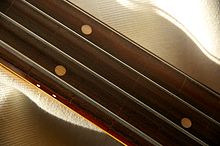
Back وتر (موسيقى) Arabic Струна Bulgarian Corda (música) Catalan ژێ (مۆسیقا) CKB Struna Czech Хĕлĕх (мусăк) CV Streng Danish Saite German Χορδή (μουσική) Greek Kordo Esperanto
This article needs additional citations for verification. (January 2019) |

A string is the vibrating element of chordophones such as the guitar, harp, piano (piano wire), and the violin family, that produces sound. Strings are lengths of a flexible material that a musical instrument holds under tension so that they can vibrate freely, but with control. This is to make the string vibrate at the desired pitch, while maintaining a low profile and sufficient flexibility to play in action.
There are two main kinds of strings; plain and wound. "Plain" strings are simply one piece of cylindrical material, commonly consisted of nylon or gut, while "wound" strings have a central core, plus other material which is tightly wound around the string (usually made of various metals).[1]
Prior to World War II, strings of many instruments (including violins and guitars) were composed of a material known as catgut, a type of cord made from refined natural fibers of animal intestines. This was the status quo until the 1950s, when mainstream popularity fell for gut strings, and steel and nylon strings became more favored in string making. Although catgut is still prized by many musicians today, due to its unique sound.[2] The invention of wound strings (particularly steel) was a crucial step in string instrument technology, because a metal-wound string can produce a lower pitch than a plain gut string of similar thickness. This enabled stringed instruments to be made with thinner bass strings.
On string instruments that the player plucks or bows directly (e.g., double bass), this enabled instrument makers to use thinner strings for the lowest-pitched strings, which made the lower-pitch strings easier to play. On stringed instruments in which the player presses a keyboard, causing a mechanism to strike the strings, such as a piano, this enabled piano builders to use shorter, thicker strings to produce the lowest-pitched bass notes, enabling the building of smaller upright pianos designed for small rooms and practice rooms.
- ^ Sweetwater (2009-12-10). "Wound or Unwound?". inSync. Retrieved 2024-01-04.
- ^ Pecotić, Iva (May 2023). "HE HISTORY, EVOLUTION, AND MAINTENANCE OF VIOLIN STRINGS". University of North Dakota. Retrieved January 10, 2024.
© MMXXIII Rich X Search. We shall prevail. All rights reserved. Rich X Search